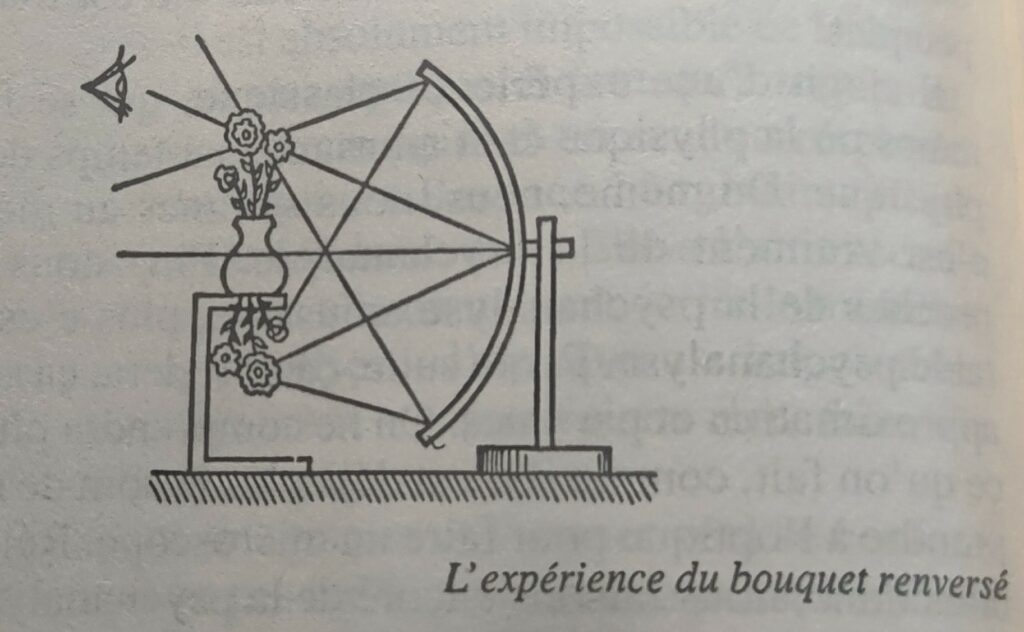Suppose that this is a box, hollow on this side, and that it’s placed on a stand, at the centre of the half-sphere. On the box, you will place a vase, a real one. Beneath it, there is a bouquet of flowers. So, what is happening?
Jacques Lacan, The Seminar of Jacques Lacan – Book I – Freud’s paper on Technique (1953-1954), Trans. John Forrester, Norton Paperback, New-York, 1991, p. 77-78
The bouquet is reflected in the spherical surface, meeting at the symmetrical point of luminosity. Consequently, a real image is formed. Note that the rays do not quite cross perfectly in my schema, but that is also true in reality, and for all optical instruments – one only ever gets an approximation. Beyond the eye, the rays continue their movement, and diverge once again. But for the eye, they are convergent, and give a real image, since the characteristic of rays which strike the eye in a convergent form is that they give a real image. Convergent in meeting the eye, they diverge in moving away from it. If the rays happen to meet the eye in the opposite sense, then a virtual image is formed. This is what happens when you look at an image in the mirror – you see it where it isn’t. Here, on the contrary, you see it where it is – on the one condition that your eye be in the field of the rays which have already crossed each other at the corresponding point.
At that moment, while you do not see the real bouquet, which is hidden, if you are in the right field, you will see a very peculiar imaginary bouquet appear, taking shape exactly in the neck of the vase. Since your eyes have to move linearly in the same plane, you will have an impression of reality, all the while sensing that something is strange, blurred, because the rays don’t quite cross over very well. The further away you are, the more parallax comes into play, and the more complete the illusion will be.
Supposez que ceci soit une boîte, creuse de ce côté-là, et qu’elle soit placée sur un pied, au centre de la demi sphère. Sur la boîte, vous allez mettre un vase, réel. En dessous, il y a un bouquet de fleurs. Alors, qu’est-ce qui se passe ?
Jacques Lacan, Le Séminaire – Livre I – Les écrits techniques de Freud (1953-1954), Le Seuil, 1998, p. 126-127
Le bouquet se réfléchit sur la surface sphérique, pour venir au point lumineux symétrique. Entendez que tous les rayons en font autant, en vertu de la propriété de la surface sphérique – tous les rayons émanés d’un point donné viennent au même point symétrique. Dès lors, se forme une image réelle. Notez que les rayons ne se croisent pas tout à fait bien dans mon schéma, mais c’est vrai aussi dans la réalité, et pour tous les instruments d’optique – on n’a jamais qu’une approximation. Au-delà de l’œil, les rayons continuent leur chemin, et redivergent. Mais pour l’œil, ils sont convergents, et donnent une image réelle, puisque la caractéristique des rayons qui frappent un œil sous une forme convergente, c’est de donner une image réelle. Convergents en venant à l’œil, ils divergent en s’en écartant. Si les rayons viennent frapper l’œil en sens contraire, c’est une image virtuelle qui se forme. C’est ce qui se passe quand vous regardez une image dans la glace – vous la voyez là où elle n’est pas. Ici, au contraire, vous la voyez là où elle est à cette seule condition que votre œil soit dans le champ des rayons qui sont déjà venus se croiser au point correspondant.
A ce moment-là, alors que vous ne voyez pas le bouquet réel, qui est caché, vous verrez apparaître, si vous êtes dans le bon champ, un très curieux bouquet imaginaire, qui se forme juste sur le col du vase. Comme vos yeux doivent se déplacer linéairement sur le même plan, vous aurez une impression de réalité, tout en sentant que quelque chose est bizarre, brouillé, parce que les rayons ne se croisent pas très bien. Plus vous serez loin, plus la parallaxe jouera, et plus l’illusion sera complète.
Jacques Lacan, Le Séminaire – Livre I – Les écrits techniques de Freud (1953-1954), Le Seuil, 1998, p. 126-127
